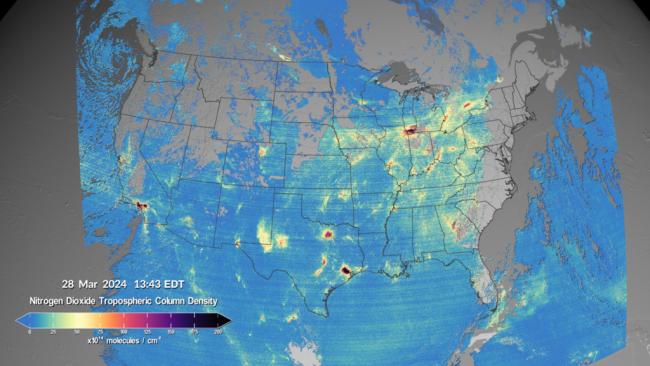Valuable air quality collected by the TEMPO mission is now being released to the public. TEMPO is a collaboration between SAO, NASA, and other partners.

Cambridge, MA-- Air pollution data on a neighborhood scale are now available in near real-time from the TEMPO instrument (Tropospheric Emissions: Monitoring of Pollution). The mission gathers hourly daytime scans of the atmosphere over North America from the Atlantic Ocean to the Pacific Coast and from roughly Mexico City to central Canada.
The primary instrument on TEMPO, a collaboration between NASA and the Smithsonian Astrophysical Observatory (SAO), is an advanced spectrometer that detects pollution within the troposphere, the lowest layer of Earth’s atmosphere.
"TEMPOs data will play an important role in the scientific analysis of pollution," said senior physicist Xiong Liu at SAO, a member of the Center for Astrophysics | Harvard & Smithsonian (CfA), and principal investigator for TEMPO. "For example, we will be able to conduct studies of rush hour pollution; linkages of diseases and health issues to acute exposure of air pollution; how air pollution inordinately impacts underserved communities; the potential for improved air quality alerts; the effects of lightning on ozone; and the movement of pollution from forest fires and volcanoes."
"Previous satellite instruments in low-Earth orbit measure a given location on the ground once per day, always at the same time. However, air quality can change a lot over a day. For instance, cities usually have two rush hour peaks in pollution, and changing winds mean a plume from a power plant could be changing direction hour-to-hour," said TEMPO team member Caroline Nowlan at SAO. "TEMPO is so ground-breaking because it is in an orbit that allows us to continuously scan North America, and, for the first time, allows us to monitor pollution over all daylight hours."
Scientists at SAO conceived the concept of TEMPO and developed ground systems hardware and software, responsible for commanding the instrument and receiving and processing its raw data into science data products. After initial processing, the data are posted to NASA's Atmosphere Science Data Center (ASDC) at Langley Research Center in Hampton, Virginia, where they are now made available to scientists and the public.
An early adopter program has allowed policymakers and other air quality stakeholders to understand the capabilities and benefits of TEMPO's measurements. Since October 2023, the TEMPO calibration and validation team has been working on evaluating and improving the various TEMPO data products.
"All the pollutants that TEMPO is measuring cause health issues," said Hazem Mahmoud, science lead at NASA’s ASDC. "We have more than 500 early adopters that will be using these datasets right away. We are looking at epidemiologists and health researchers using this data in the future. We are looking at anybody who's studying the respiratory system and needs to answer questions about the impact of these pollutants on health." Measurements by TEMPO include air pollutants such as nitrogen dioxide, formaldehyde, and ground-level ozone.
"Poor air quality exacerbates pre-existing health issues, which then leads to more hospitalizations," said Jesse Bell, executive director at the University of Nebraska Medical Center’s Water, Climate, and Health Program. Bell is an early adopter of TEMPO’s data.
Bell noted that there is a lack of air quality data in rural areas since monitoring stations are often hundreds of miles apart. There is also a noticeable disparity in air quality from neighborhood to neighborhood. "Low-income communities, on average, have poorer air quality than more affluent communities," said Bell.
"Hourly, high spatial resolution observations by TEMPO provide novel datasets for improving emission estimates, monitoring pollution exposure, and enabling stakeholder communities to better understand the impacts of poor air quality," said Huiqun Wang, a physicist and TEMPO team member at SAO. Determining sources of air pollution can be difficult as smoke from wildfires or pollutants from industry and traffic congestion drift on winds. TEMPO should make it easier to trace the origin of some pollutants.
Erika Wright, a science educator at SAO, is excited to put TEMPO data in the hands of students, educators, and the public. "We are working with CfA scientists and educators on the development of new user-friendly data visualization tools so that public audiences can access and monitor air quality data in their own communities and across North America."
A new TEMPO data visualization tool, created by the Cosmic Data Stories team at the CfA, is available at tempo.si.edu/data_for_public.html.
TEMPO was built by BAE Systems, Inc., Space & Mission Systems (formerly Ball Aerospace) and was launched from Cape Canaveral Space Force Station in Florida on Friday, April 7, 2023. It flies aboard the Intelsat 40e satellite built by Maxar Technologies. The TEMPO Ground System, including the Instrument Operations Center and the Science Data Processing Center, are operated by the SAO part of CfA, in Cambridge, Massachusetts.
For more information about the TEMPO Instrument and Mission, visit https://tempo.si.edu.
About the Center for Astrophysics | Harvard & Smithsonian
The Center for Astrophysics | Harvard & Smithsonian is a collaboration between Harvard and the Smithsonian designed to ask—and ultimately answer—humanity's greatest unresolved questions about the nature of the universe. The Center for Astrophysics is headquartered in Cambridge, MA, with research facilities across the U.S. and around the world.
Media Contact
Megan Watzke
Interim CfA Public Affairs Officer
Center for Astrophysics | Harvard & Smithsonian
617-496-7998
mwatzke@cfa.harvard.edu
Related News
TEMPO Instrument Captures Its First Images of Air Pollution Over Greater North America
The Case of the Missing Jupiters: Gas Giant Planets are a No-Show around Small Red Stars
Astronomers Find Potentially Volcano-Covered Earth-Size World
Incoming Postdoc, Outgoing Grad Awarded 51 Pegasi B Fellowships
TEMPO Instrument Arrives Safely in Florida
Media Advisory: New Space Instrument To Deliver Near Real-Time Air Pollution Data
First Rocky Exoplanet Confirmed with NASA's JWST
A Leading Light in Atmospheric Science
New from JWST: An Exoplanet Atmosphere as Never Seen Before
Astronomers Warn of Risk of Misinterpreting JWST Planetary Signals
Projects
AstroAI
GMACS
For Scientists